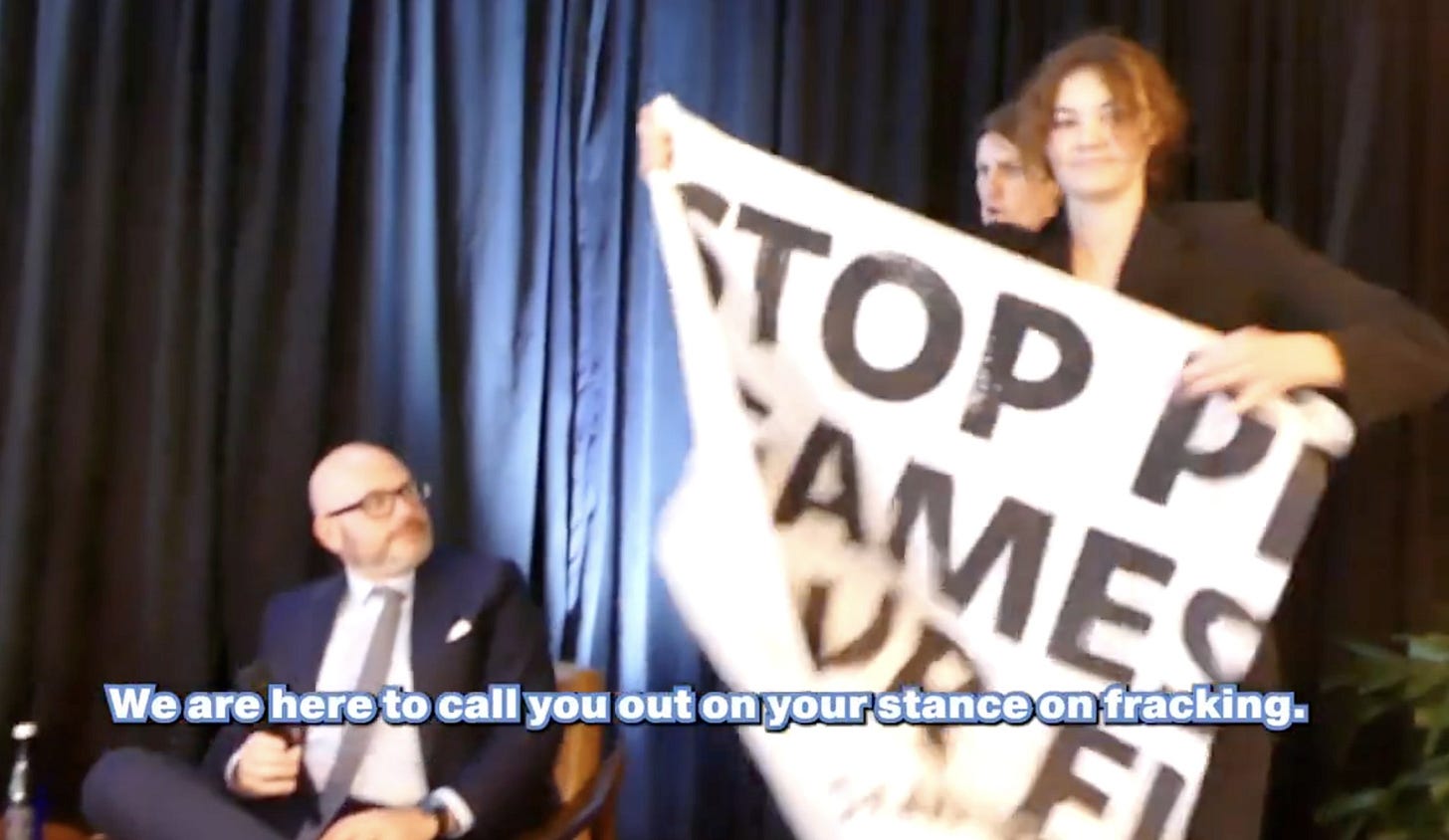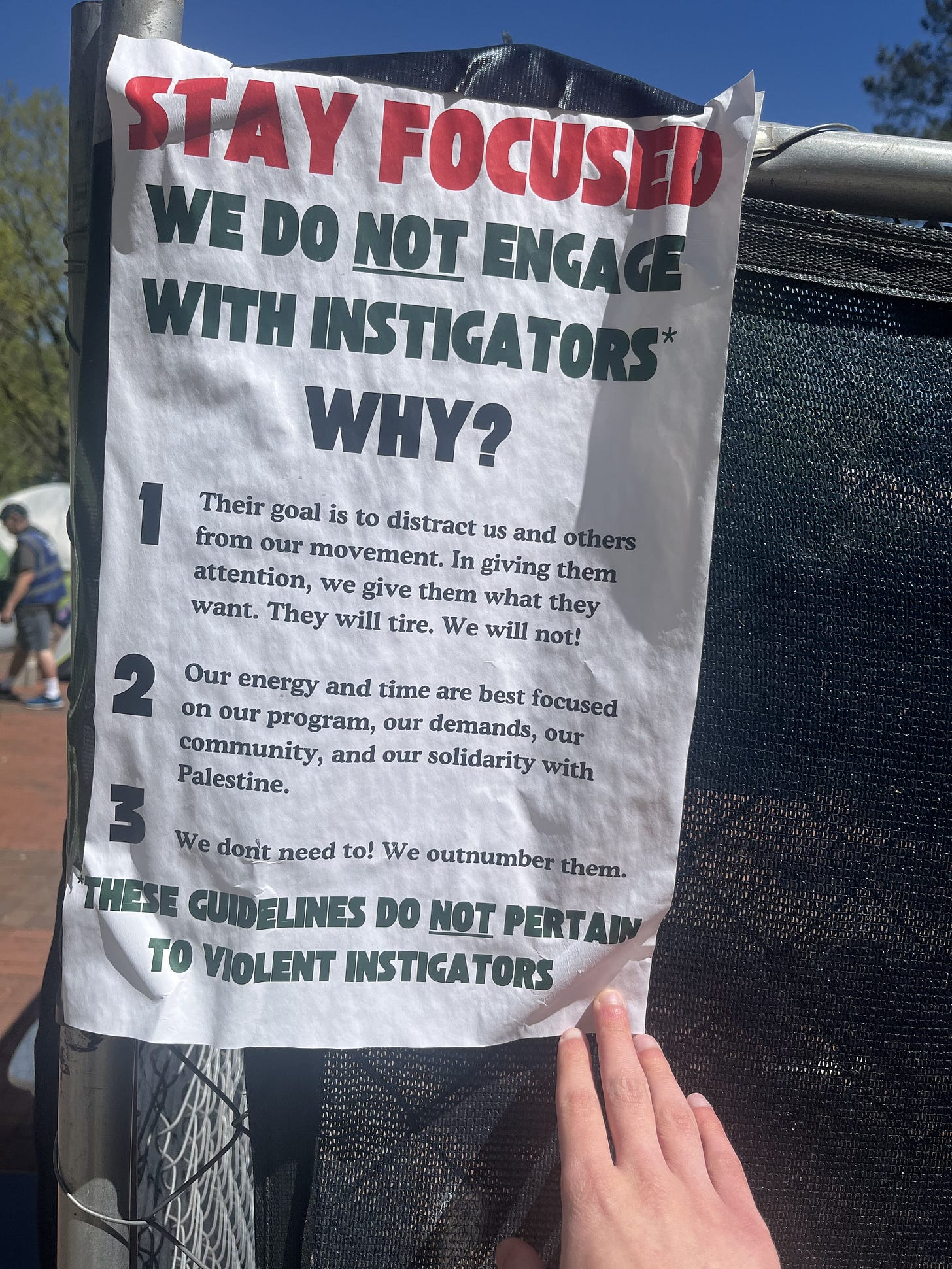Why Are So Many Left-Wing Protests So Offputting?
Incentives and selection effects
Recently, some left-wing anti-fracking climate activists succeeded in making Matt Yglesias look very cool.
Unfathomably cool! Cool probably at a level that nobody has ever seen before. Yglesias’s high school bullies are now, like Biff in Back to the Future, regretting every mean thing they ever said to him. They have now recognized that he is cooler than them, that he should have been the one to stuff them in the lockers and take their lunch money. Some of them are currently sending him their lunch money in the mail, overcome by such a firm conviction that, in accordance with the high school law, it is fitting and proper for one who is unfathomably cooler than another to take the lunch money of the other.
How did they do this? Well, they confronted Yglesias, perhaps the most chill, mild-mannered human to ever walk the Earth, at a luncheon, aiming to confront him on fracking.
Yglesias recently wrote an article defending fracking. These folks weren’t happy about that. They stormed on stage, began yelling about climate change destroying the planet, and asked Yglesias what he had to say for himself. Yglesias, having been born for such an occasion, immediately began calmly discussing the reasons that fracking is good, before the protestors cut him off to accuse him of being a “weak, simplistic mouthpiece.” Unlike Yglesias’s simplistic mouthpiecery, they offered nuanced, detailed, policy analysis, saying things like “Yglesias lies, the planet dies,” (which, of course, being incompetent, they miscaptioned as “Yglesias lies, the plant dies.”)
This is, of course, not the first example of left-wing climate activists being extremely off-putting to the general public. From throwing soup on famous paintings to spreading orange dust at Stonehenge, it seems that there are inevitably left-wing climate activists engaged in some bizarre, deeply performative form of protest. And this isn’t even mentioning the Gaza protestors who set up encampments across a sizeable share of American universities, advocating for an ineffective and ill-defined divestment program that was doomed to fail. Despite allegedly raising awareness, after taking over huge swathes of campus, they explained that they wouldn’t talk with those who disagreed because they outnumbered their critics (in, remember, the spaces THEY SET UP).
(This sign was up at my University. My hand makes a guest appearance in the above image).
So why is this? What is it that drives the left to engage in such bizarre performance art? Right-wing protests aren’t like this—somehow it just seems to be the left. So why is this?
In part, the answer has to do with selection effects. There are smaller, less performative protest movements. They’re just busy doing serious, productive things like lobbying legislators rather than interrupting Yglesias’s lunch-eating. As Scott Alexander has noted:
Of course, this is par for the course for PETA, who have previously engaged in campaigns like throwing red paint on fashion models who wear fur, juxtaposing pictures of animals with Holocaust victims, juxtaposing pictures of animals with African-American slaves, and ads featuring naked people that cross the line into pornography.
People call these things “blunders”, but consider the alternative. Vegan Outreach is an extremely responsible charity doing excellent and unimpeachable work in the same area PETA is. Nobody has heard of them. Everybody has heard of PETA, precisely because of the interminable stupid debates about “did this publicity stunt cross the line?”
Second, it’s plausibly just a generic feature of left-wing psychology that left-wingers like this stuff more than others. It’s hard to imagine, for instance, Glenn Beck cheering on the people who crash a luncheon the way Nathan Robinson did. It’s no surprise that more actors are left-wing than right-wing. There is likely some brute psychological correlation between left-wing politics and theater, making those with a greater interest in theater more like to support the Democrats.
It may seem like a copout to have the explanation of A and B correlating be a brute psychological correlation between A and B, but…sometimes two things just brutely correlate. Sorry! Sometimes the reason for various correlations is not very satisfying.
The last explanation of the correlation is that leftists tend to think things that are going wrong are extremely serious and yet ignored. They think there’s an ongoing genocide going on when it comes to Gaza and that climate change will cause us all to be vaporized in a few decades. If something like that was actually occurring, if we were actually likely to be vaporized in a few decades, or the U.S. was complicit in a global holocaust, then more extreme forms of protest would make more sense.
You might wonder: the right also tends to think many of these things. They think we’re being overrun by hordes of Haitians—coming for your cats and dogs, who will eviscerate American institutions. So why doesn’t the right engage in these sorts of bizarre, performative protests. Part of the answer, is of course, the other factors I listed. But part of it is just: the right doesn’t seem to do many protests.
While occasionally right-wing protests erupt for some reason or another, they’re far more common on the left. I couldn’t find data on this, so my perception could be off, but it does seem like the left has a much greater love of protests. Protesting is seen as a core part of the left-wing intellectual tradition. The Vietnam protestors of the 60s are seen as heroes. The most famous public intellectual of the left, Noam Chomsky, has attended various protests, including ones where he was arrested. Nothing similar is true of right-wingers.
Right-wingers do sometimes carry out protests. In a recent famous one, right-wingers marched down to the capital to put pressure on Mike Pence to overturn a free and fair election, before breaking in with the intention of killing Mike Pence and various left-wing politicians. By far the most dangerous recent protest, therefore, was carried out by the right. But still, in terms purely of raw numbers, protests seem mostly to be a left-wing phenomenon.
When you combine those four factors—protests being more common on the left, the left believing more radical narratives, greater theatrics among left-wingers, and selection effects—it’s no surprise that you hear so frequently about extremely offputting public protests.






You see less protests on the right because the media is not sympathetic to protests on the right, so there is little benefit. As a case in point, in the late 80s and early 90's "Operation Rescue" was an organized pro-life activist protest movement. Pro-life protesters blocked the doors of abortion clinics with their bodies, preventing entry. These were very controversial protests, with abortion clinics and pro-choice groups claiming that the protesters caused violence and property damage, while the pro-life protest groups claimed they were peaceful but often attacked by police and counter-protesters.
Certainly the movement had a lot in common with left wing protests, such as sit-ins or blocking traffic or taking over events and the like. The main difference is that in the case of Operation Rescue the media coverage was almost universally negative. When a left wing group blocks a road, they can expect to get a lot of sympathetic media attention and get the word out. When Operation Rescue blocked abortion clinic doors, they got headlines describing them as militant, exteme, aggressive, and violent. The articles were full of sympathetic quotes form abortion clinic employees and pro-choice activists testifying as to how they were victimized by the protesters. In essence, the protests gave their opponents an opportunity to spread awareness, and the media coverage made their own side look barbaric. I'm not saying there was a media conspiracy or anything; there didn't have to be. Most journalists were pro-choice, with no incentive to cover the protests sympathetically.
As for the protesters, they were arrested en masse and for the most part the justice system threw the book at them. In 1994 the Supreme Court ruled that abortion clinics could use RICO, a 1970s anti-organized crime law, to sue Operation Rescue protesters. Under RICO they could sue for triple monetary damages and prison sentences of up to 20 years for individual protesters. As one fairly typical example, a pastor named Randy Alcorn who participated in the protest (and was arrested multiple times as a result) was sued under the RICO law, and was required to pay the abortion clinic he protested $8.2 million in damages. They garnished his wages, so in order to pay the clinic as little money as possible Alcorn quit his job and has worked at minimum wage ever since. Alcorn was not an unusual example.
Then in 1994 Congress passed the FACE act which made it a federal offense to use physical obstruction to interfere with any person obtaining an abortion. First time non-violent violators face up to six months in prison and $10,000 in fines, with up to 18 months in prison or $25,000 in fines for repeat non-violent violations. Operation Rescue was pretty much dead in the water after that.
In other words, when the right wing protests the way the left wing protests, they do not get any benefit from media coverage, they go to jail, and they get sued under the same rules that apply to mobsters. That's why you see less of it: the consequences are far harsher than for left wing protesters.
Westboro Baptist would be the one right-wing example that goes for theater and garish signs. They share the urgency about something extremely serious and yet widely ignored.
As an evangelical myself, the funny thing is, we believed some of the same things technically as Westboro, but most Christians lack the kind of psychology that wants to do that sort of thing. Street evangelism is the furthest some go.
I think that left-wingers are undergoing a psychology of religious conversion effectively.